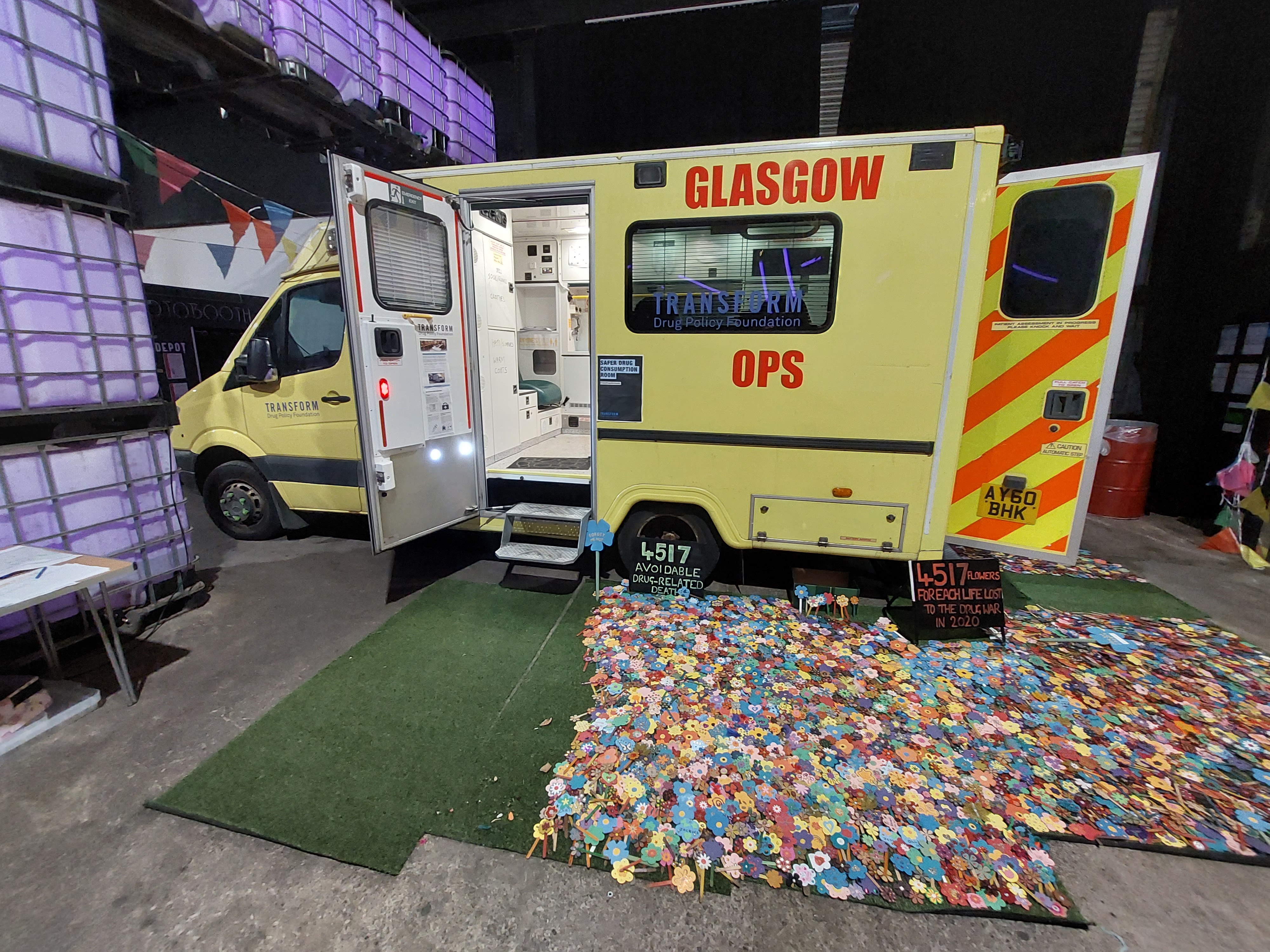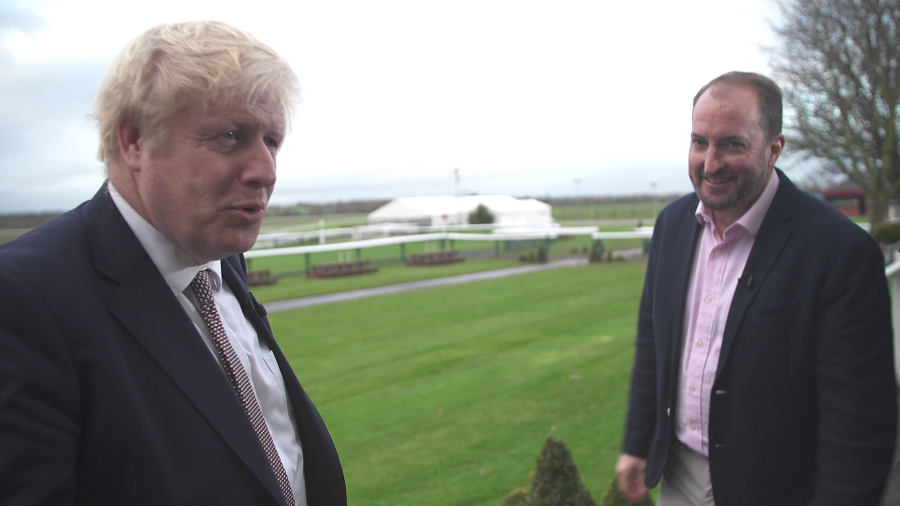
Drug Consumption Rooms – What Are They & Why Are Drugs Workers Fighting For Change?
An innovative public health policy used across the world could be the answer to Wales’ spiralling drug death count, with latest figures up 40% on the previous year.
Drug consumption rooms are safe places for users to shoot up drugs bought on the street with clean needles in front of medics with help to get clean on offer.
Pilot programmes like the Fixelance in Denmark and the Glasgow OPS in Scotland give hope that activists can push for change via civil disobedience.
By Mark S Redfern
An ambulance with the letters “OPS” written in large red lettering on its side could be seen inside a conference hall in Cardiff last month. Its doors were flung open waiting for people to poke their heads inside.
The vehicle was an Overdose Prevention Service that had previously been operated on the streets of Scotland – against the law – by ex-user turned activist Peter Krykant. He was spurred into action by Glasgow’s spiralling heroin death rate.
The vehicle had made a pit-stop in Llanelli earlier this year as the Transform Drug Policy Foundation paraded the success of the pilot project, which saw the ambulance facilitate thousands of heroin injections with clean needles and even saved the lives of some overdosing drug users.
This is the crux of drug consumption rooms (DCRs) that have been in operation by governments and activists across the globe for decades. It was visiting Wales in another push to rally support for better facilities for drug users.
The event was being held in the DEPOT, Cardiff, and was organised by Swansea-based drug workers Barod, celebrating the organisation’s 50th birthday and marking the hard work done by those helping drug users on Welsh streets and pushing for radical drug reform.
Drug deaths in Wales have skyrocketed in Wales with 210 deaths in 2021 – compared with 149 in 2020, leaving charities like Barod to deal with the consequences of inadequate government health policies.
Caroline Phipps, CEO of Barod, spoke to an audience of Welsh drug workers from the conference hall stage: “I think for me and Barod and for Wales, and for Welsh drug policy, absolutely we can get enhanced harm reduction centres [DCRs]. There should be nothing stopping us. It’s criminal that we’re not doing it already,” she said.
“What we’re seeing is people who use drugs and alcohol who come to our services and are in need, it’s so linked to poverty, deprivation, and inequalities and laws that are just not fit for purpose.”
“In Wales we could reclaim the ability to have our own laws, change the laws, make a difference, save lives. That is an aspiration, I know, but you’ve got to aim high… and an independent Wales!”
Central to Barod’s ethos is harm reduction, an acknowledgement that people will take illicit drugs and that giving drug users clean needles at exchanges and safe places to inject in DCRs is more helpful to getting them off smack than shunning drug users from society by making them criminals.
DCRs are a vital tool in the struggle for progress. Countries like Denmark have static rooms that users from across the city can visit to take heroin bought on the street under the watchful eye of medical professionals trained to reverse overdoses with miracle-antidote Naloxone.
Users are given clean needles to shoot up with and are offered an array of aftercare services, not only opportunities to get clean but often help with housing concerns, state welfare forms, and testing for blood-borne viruses like Hepatitis and HIV.
But before Denmark had a permanent DCR operated by a government agency the pressure was piled on by activists on the street proving it could work.
One such activist was Michael Lodberg Olsen, who went out onto the Copenhagen roads with a team of volunteers and his Fixelance, a converted German ambulance decked out to offer all the necessities of a static DCR but on a much smaller scale.
The original Fixelance was such a success it has been retired and now lives in the National Museum of Denmark. Its legacy of civil disobedience lives on through projects like Peter Krykant’s Glasgow OPS, which has been studied to show that DCRs make an impact in Scotland.
Cautious words from Wales’ First Minister on the subject of DCRs might inspire hope that one day the country will have the facilities for drug users it so desperately needs.
“I don’t rule it out,” said Mark Drakeford in March. “You can’t deal with it, in my view, through a criminal justice response… it’s about recognising the reality that there are people whose lives have been taken over in that way, and that it’s better for us all if we can find a way to help them with their addiction that is manageable and safe.”
At the moment, though, few steps have been taken by the Welsh Labour government headed by Drakeford to commit to any policy that would help drug users inject safer. And although health matters are devolved, crime and punishment are still controlled by Westminster. Only recently, the UK Home Secretary has pushed for drug policy to become even more draconian by calling for cannabis to become a Class A substance.
As things stand in Wales, users still have to shoot up in alleyways and undergrowth and that shows no sign of changing in the near future. Drug workers in Wales continue to push for lifesaving harm reduction policies all the same.
Although the Barod event had invited drug workers to think positively that the battle for safe consumption and genuine help will be won, there were remembrances of those lost to inaction inside the entrance lobby, organised so that one must almost step over them to enter and exit.
A lake of small wooden flowers were laid out in front of the Scottish ambulance near the door to the event. Each flower had been placed there to represent a death that had been attributed to the UK and Welsh Government’s lack of care for drug use deaths.
The flowers had names: Ollie, Barney, Jade, Christopher, Jack, Luke, Lydia, Ross, Jessica, Colin, Robin, Jacques, Lester, Ben, Zoe, Jay, Gareth, and it continued on.


